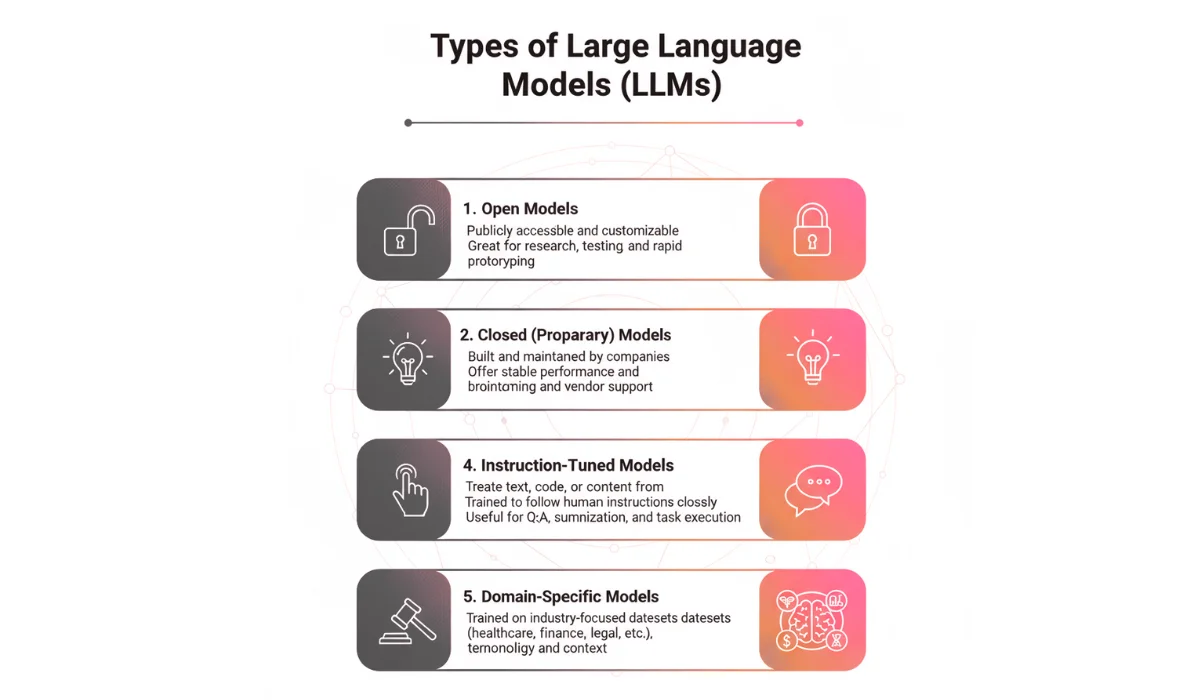Large Language Models, or LLMs, have become one of the most talked-about technologies in AI today. From powering chatbots like ChatGPT to assisting developers in writing code, LLMs are changing the way businesses interact with information and customers. Therefore, businesses looking to integrate AI into their workflows are increasingly exploring LLM development services to build and deploy models tailored to their specific needs.
However, to utilize these services effectively, one must fully understand the concept of LLMs. In this guide, we’ll break down what LLMs are, how they work, the different types you might encounter, and practical applications for businesses. By the end, you’ll have a clear, actionable understanding of this technology and why it matters.
What Are Large Language Models?

A large language model is a type of artificial intelligence designed to process and generate text. Unlike traditional software, which follows a fixed set of rules, LLMs learn from patterns in language data. Think of them as a librarian who has read millions of books and can answer your questions or summarize information on demand.
These models are “large” because they contain billions, or even trillions, of parameters, which are the parts of the model that store learned language knowledge. The more parameters a model has, the better it can capture the nuances of grammar, context, and meaning.
Some of the most well-known LLMs include OpenAI’s GPT series, Google’s PaLM, Anthropic’s Claude, and Meta’s LLaMA. Each has its strengths, such as general-purpose text generation, instruction-following, or domain-specific knowledge. Businesses use them in a variety of ways, from automating customer support to generating content and assisting in decision-making.
In simple terms, LLMs are AI systems that understand and generate human-like language at scale. Businesses can integrate LLMs into workflows today.
How Large Language Models Work
Large Language Models are built to predict text based on patterns they’ve learned from enormous datasets. They don’t “think” like humans, but they excel at recognizing patterns, context, and relationships between words. Here’s a high-level view of how they function:
- Training on Massive Texts: LLMs are fed billions of words from books, articles, websites, and other sources. This gives them a broad understanding of grammar, vocabulary, and how ideas are connected.
- Learning Patterns: Using these texts, the model adjusts its internal parameters, billions of tiny numbers that guide how it predicts the next word in a sentence. This process is called “training.”
- Generating Predictions: When you give an LLM a prompt, it uses its learned patterns to predict what comes next, word by word. The output can be an answer to a question, a paragraph of text, or even code.
Key concepts to understand:
- Tokens: LLMs break text into smaller units called tokens, which can be words or parts of words. However, there is a token limit that can affect the model’s performance.
- Parameters: These are the model’s internal settings that store its knowledge of language patterns.
- Context Window: LLMs consider a certain amount of preceding text (the context window) to generate coherent responses.
Think of it like autocomplete on steroids. Instead of suggesting one word at a time on your phone, an LLM can generate entire paragraphs, maintain context, and even follow instructions in a conversation. The scale and flexibility are what make them “large” and powerful.
Types of Large Language Models You Can Experiment With

LLMs come in different varieties, each designed for specific purposes and use cases. Understanding the types helps businesses select the right model for their goals.
1. Open Models
Open models are publicly accessible and often allow customization or fine-tuning. They are trained on large datasets and can be adapted for multiple use cases, from research to practical applications in business.
Benefits:
- Flexible experimentation and rapid prototyping
- Ability to fine-tune for specific tasks or proprietary data
- Cost-effective for testing and small-scale deployment
2. Closed (Proprietary) Models
Closed models are developed and maintained by companies, and their internal workings are not publicly available. They are designed to offer stable performance and often come with dedicated support and enterprise-level reliability.
Benefits:
- Reliable and consistent output quality
- Maintained updates and vendor support
- Better security and compliance for sensitive business use
3. Generative Models
Generative models are designed to produce text, code, or other content from a given prompt. They excel at creating coherent and creative outputs without specific instructions, making them useful for brainstorming or drafting content.
Benefits:
- Quickly generate content, ideas, or drafts
- Support creative tasks like writing marketing copy or generating code
- Reduce manual workload for repetitive writing tasks
4. Instruction-Tuned Models
Instruction-tuned models are trained to follow human instructions more accurately. They are optimized to perform tasks such as answering questions, summarizing text, or providing step-by-step guidance.
Benefits:
- More reliable for task-oriented applications like chatbots and virtual assistants
- Produce structured, actionable outputs
- Reduce errors when executing specific workflows
5. Domain-Specific Models
Domain-specific models are trained on specialized datasets from industries such as healthcare, legal, finance, or engineering. They understand terminology, conventions, and context unique to that sector, which improves accuracy for professional applications.
Benefits:
- High precision in niche or specialized tasks
- Minimized need for manual editing or post-processing
- Supports industry compliance and context-sensitive applications
Also Read: LLM vs. LCM: AI Model Comparison for Business Leaders
Where to Use Large Language Models

LLMs are being applied across industries to solve real business problems. Here are some practical use cases:
- Customer Support Automation: AI chatbots can answer routine queries, reducing wait times and freeing human agents for complex cases.
- Content Generation: From marketing copy to product descriptions, LLMs can draft text quickly and consistently.
- Code Assistance: Developers can use LLMs to generate boilerplate code, debug, or document software.
- Knowledge Management: LLMs can summarize reports, highlight key insights, and make information easier to find within large organizations.
- Decision Support: By analyzing data and generating natural-language summaries, LLMs help managers and analysts make faster, informed decisions.
Implementing LLMs can save time, reduce costs, and scale processes that previously relied on manual effort. While the technology is powerful, it works best when combined with human oversight to ensure accuracy and relevance.
Is There Any Drawback to Large Language Models?
While LLMs are powerful, they are not perfect. Understanding their limitations before taking LLM development services is essential for using them effectively in business.
- Hallucinations: LLMs sometimes generate information that sounds plausible but is actually incorrect. They lack a built-in fact-checking mechanism.
- Bias in Data: Models reflect the data on which they were trained. If the training data contains biases, the model’s output can unintentionally reproduce them.
- Data Privacy Concerns: Feeding sensitive or proprietary information into an LLM may pose security risks, especially with cloud-based models.
- High Computational Costs: Training and running LLMs can require significant computing power, which impacts cost and environmental footprint.
These challenges don’t make LLMs unusable; they just mean that human oversight, thoughtful integration, and clear use-case boundaries are critical.
Getting Started with LLMs
For beginners, experimenting with LLMs can be surprisingly approachable. Here’s a simple roadmap:
- Try Existing Tools: Platforms like OpenAI Playground, Hugging Face, and Google’s AI Studio allow you to interact with LLMs without deep technical expertise.
- Start Small: Test prompts, ask questions, or generate small content pieces before integrating LLMs into larger workflows.
- Learn Prompt Engineering: The way you phrase inputs directly affects output quality. Simple adjustments can make responses more accurate and useful.
- Enterprise Considerations: When using LLMs in business, consider compliance, data privacy, and whether an open-source or proprietary model better suits your needs.
Even small, controlled applications such as automating email responses or summarizing internal reports can show immediate value and build confidence in the technology.
Conclusion & Key Takeaways
Large Language Models are no longer just a concept in AI research; they are practical tools that businesses can use to process language, automate tasks, and make better decisions. By understanding what LLMs are, how they work, and their applications, even beginners can start exploring their potential responsibly.
What you should remember:
- LLMs generate human-like text by learning patterns from massive datasets.
- There are open vs. closed, generative vs. instruction-tuned, and domain-specific models, each with distinct benefits.
- LLMs are not without limitation; they can hallucinate, be biased, and pose risk, making human oversight essential.
- Beginners can start small, experiment with existing tools, and gradually scale LLM integration into business workflows. Taking large language model development services is best if you lack an in-house team.
LLMs represent a powerful opportunity to improve efficiency, creativity, and decision-making. The best approach is to combine experimentation with thoughtful governance, which ensures that businesses can harness their potential safely and effectively.



